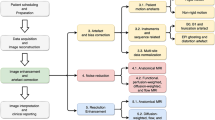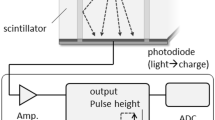Abstract
Objective
We demonstrate the feasibility of direct generation of attenuation and scatter-corrected images from uncorrected images (PET-nonASC) using deep residual networks in whole-body 18F-FDG PET imaging.
Methods
Two- and three-dimensional deep residual networks using 2D successive slices (DL-2DS), 3D slices (DL-3DS) and 3D patches (DL-3DP) as input were constructed to perform joint attenuation and scatter correction on uncorrected whole-body images in an end-to-end fashion. We included 1150 clinical whole-body 18F-FDG PET/CT studies, among which 900, 100 and 150 patients were randomly partitioned into training, validation and independent validation sets, respectively. The images generated by the proposed approach were assessed using various evaluation metrics, including the root-mean-squared-error (RMSE) and absolute relative error (ARE %) using CT-based attenuation and scatter-corrected (CTAC) PET images as reference. PET image quantification variability was also assessed through voxel-wise standardized uptake value (SUV) bias calculation in different regions of the body (head, neck, chest, liver-lung, abdomen and pelvis).
Results
Our proposed attenuation and scatter correction (Deep-JASC) algorithm provided good image quality, comparable with those produced by CTAC. Across the 150 patients of the independent external validation set, the voxel-wise REs (%) were − 1.72 ± 4.22%, 3.75 ± 6.91% and − 3.08 ± 5.64 for DL-2DS, DL-3DS and DL-3DP, respectively. Overall, the DL-2DS approach led to superior performance compared with the other two 3D approaches. The brain and neck regions had the highest and lowest RMSE values between Deep-JASC and CTAC images, respectively. However, the largest ARE was observed in the chest (15.16 ± 3.96%) and liver/lung (11.18 ± 3.23%) regions for DL-2DS. DL-3DS and DL-3DP performed slightly better in the chest region, leading to AREs of 11.16 ± 3.42% and 11.69 ± 2.71%, respectively (p value < 0.05). The joint histogram analysis resulted in correlation coefficients of 0.985, 0.980 and 0.981 for DL-2DS, DL-3DS and DL-3DP approaches, respectively.
Conclusion
This work demonstrated the feasibility of direct attenuation and scatter correction of whole-body 18F-FDG PET images using emission-only data via a deep residual network. The proposed approach achieved accurate attenuation and scatter correction without the need for anatomical images, such as CT and MRI. The technique is applicable in a clinical setting on standalone PET or PET/MRI systems. Nevertheless, Deep-JASC showing promising quantitative accuracy, vulnerability to noise was observed, leading to pseudo hot/cold spots and/or poor organ boundary definition in the resulting PET images.







Similar content being viewed by others
References
Ben-Haim S, Ell P. 18F-FDG PET and PET/CT in the evaluation of cancer treatment response. J Nucl Med. 2009;50:88–99.
Zaidi H, Karakatsanis N. Towards enhanced PET quantification in clinical oncology. Br J Radiol. 2018;91:20170508.
Boellaard R. Standards for PET image acquisition and quantitative data analysis. J Nucl Med. 2009;50:11S–20.
Zaidi H, Koral KF. Scatter modelling and compensation in emission tomography. Eur J Nucl Med Mol Imaging. 2004;31:761–82.
Kinahan PE, Hasegawa BH, Beyer T. X-ray-based attenuation correction for positron emission tomography/computed tomography scanners. Semin Nucl Med. 2003;33:166–79.
Mehranian A, Arabi H, Zaidi H. Vision 20/20: magnetic resonance imaging-guided attenuation correction in PET/MRI: challenges, solutions, and opportunities. Med Phys. 2016;43:1130–55.
Arabi H, Rager O, Alem A, Varoquaux A, Becker M, Zaidi H. Clinical assessment of MR-guided 3-class and 4-class attenuation correction in PET/MR. Mol Imaging Biol. 2015;17:264–76.
Martinez-Moller A, Souvatzoglou M, Delso G, Bundschuh RA, Chefd'hotel C, Ziegler SI, et al. Tissue classification as a potential approach for attenuation correction in whole-body PET/MRI: evaluation with PET/CT data. J Nucl Med. 2009;50:520–6.
Arabi H, Koutsouvelis N, Rouzaud M, Miralbell R, Zaidi H. Atlas-guided generation of pseudo-CT images for MRI-only and hybrid PET–MRI-guided radiotherapy treatment planning. Phys Med Biol. 2016;61:6531–52.
Mehranian A, Zaidi H. Joint estimation of activity and attenuation in whole-body TOF PET/MRI using constrained Gaussian mixture models. IEEE Trans Med Imaging. 2015;34:1808–21.
Rezaei A, Deroose CM, Vahle T, Boada F, Nuyts J. Joint reconstruction of activity and attenuation in time-of-flight PET: a quantitative analysis. J Nucl Med. 2018;59:1630–5.
Litjens G, Kooi T, Bejnordi BE, Setio AAA, Ciompi F, Ghafoorian M, et al. A survey on deep learning in medical image analysis. Med Image Anal. 2017;42:60–88.
Sanaat A, Arabi H, Mainta I, Garibotto V, Zaidi H. Projection-space implementation of deep learning-guided low-dose brain PET imaging improves performance over implementation in image-space. J Nucl Med. 2020; in press.
Shiri I, Leung K, Geramifar P, Ghafarian P, Oveisi M, Ay MR, et al. PSFNET: ultrafast generation of PSF-modelled-like PET images using deep convolutional neural network [abstract]. J Nucl Med. 2019;60:1369.
Haggstrom I, Schmidtlein CR, Campanella G, Fuchs TJ. DeepPET: a deep encoder-decoder network for directly solving the PET image reconstruction inverse problem. Med Image Anal. 2019;54:253–62.
Han X. MR-based synthetic CT generation using a deep convolutional neural network method. Med Phys. 2017;44:1408–19.
Jin CB, Kim H, Liu M, Jung W, Joo S, Park E, et al. Deep CT to MR synthesis using paired and unpaired data. Sensors. 2019;19:2361.
Bortolin K, Arabi H, Zaidi H. Deep learning-guided attenuation and scatter correction in brain PET/MRI without using anatomical images. IEEE Nuclear Science Symposium and Medical Imaging Conference (NSS/MIC). Manchester, UK; 2019.
Arabi H, Zeng G, Zheng G, Zaidi H. Novel adversarial semantic structure deep learning for MRI-guided attenuation correction in brain PET/MRI. Eur J Nucl Med Mol Imaging. 2019;46:2746–59.
Yang J, Park D, Gullberg GT, Seo Y. Joint correction of attenuation and scatter in image space using deep convolutional neural networks for dedicated brain (18)F-FDG PET. Phys Med Biol. 2019;64:075019.
Spuhler KD, Gardus J 3rd, Gao Y, DeLorenzo C, Parsey R, Huang C. Synthesis of patient-specific transmission image for PET attenuation correction for PET/MR imaging of the brain using a convolutional neural network. J Nucl Med. 2019;60:555–60.
Arabi H, Dowling JA, Burgos N, Han X, Greer PB, Koutsouvelis N, et al. Comparative study of algorithms for synthetic CT generation from MRI: consequences for MRI-guided radiation planning in the pelvic region. Med Phys. 2018;45:5218–33.
Jang H, Liu F, Zhao G, Bradshaw T, McMillan AB. Technical note: deep learning based MRAC using rapid ultra-short echo time imaging. Med Phys. 2018;45:3697–704.
Gong K, Yang J, Kim K, El Fakhri G, Seo Y, Li Q. Attenuation correction for brain PET imaging using deep neural network based on Dixon and ZTE MR images. Phys Med Biol. 2018;63:125011.
Leynes AP, Yang J, Wiesinger F, Kaushik SS, Shanbhag DD, Seo Y, et al. Zero-echo-time and Dixon deep pseudo-CT (ZeDD CT): direct generation of pseudo-CT images for pelvic PET/MRI attenuation correction using deep convolutional neural networks with multiparametric MRI. J Nucl Med. 2018;59:852–8.
Shiri I, Ghafarian P, Geramifar P, Leung KH, Ghelichoghli M, Oveisi M, et al. Direct attenuation correction of brain PET images using only emission data via a deep convolutional encoder-decoder (deep-DAC). Eur Radiol. 2019;29:6867–79.
Rezaei A, Defrise M, Bal G, Michel C, Conti M, Watson C, et al. Simultaneous reconstruction of activity and attenuation in time-of-flight PET. IEEE Trans Med Imaging. 2012;31:2224–33.
Mehranian A, Arabi H, Zaidi H. Quantitative analysis of MRI-guided attenuation correction techniques in time-of-flight brain PET/MRI. Neuroimage. 2016;130:123–33.
Hwang D, Kim KY, Kang SK, Seo S, Paeng JC, Lee DS, et al. Improving the accuracy of simultaneously reconstructed activity and attenuation maps using deep learning. J Nucl Med. 2018;59:1624–9.
Hwang D, Kang SK, Kim KY, Seo S, Paeng JC, Lee DS, et al. Generation of PET attenuation map for whole-body time-of-flight (18)F-FDG PET/MRI using a deep neural network trained with simultaneously reconstructed activity and attenuation maps. J Nucl Med. 2019;60:1183–9.
Wolterink JM, Dinkla AM, Savenije MHF, Seevinck PR, van den Berg CAT, Išgum I. Deep MR to CT synthesis using unpaired data. International Workshop on Simulation and Synthesis in Medical Imaging SASHIMI. Cham: Springer International Publishing; 2017. p. 14–23.
Dong X, Lei Y, Wang T, Higgins K, Liu T, Curran WJ, et al. Deep learning-based attenuation correction in the absence of structural information for whole-body PET imaging. Phys Med Biol. 2020;65(5):055011.
Watson CC. New, faster, image-based scatter correction for 3D PET. IEEE Trans Nucl Sci. 2000;47:1587–94.
Li W, Wang G, Fidon L, Ourselin S, Cardoso MJ, Vercauteren T. On the compactness, efficiency, and representation of 3D convolutional networks: brain parcellation as a pretext task. In: Niethammer M, Styner M, Aylward S, Zhu H, Oguz I, Yap P-T, et al., editors. Information Processing in Medical Imaging. Cham: Springer International Publishing; 2017. p. 348–60.
Gibson E, Li W, Sudre C, Fidon L, Shakir DI, Wang G, et al. NiftyNet: a deep-learning platform for medical imaging. Comput Methods Prog Biomed. 2018;158:113–22.
Abadi M, Barham P, Chen J, Chen Z, Davis A, Dean J, et al. TensorFlow: a system for large-scale machine learning. Proceedings of the 12th USENIX conference on Operating Systems Design and Implementation. Savannah, GA, USA: USENIX Association; 2016. p. 265–83.
Wang Z, Bovik AC, Sheikh HR, Simoncelli EP. Image quality assessment: from error visibility to structural similarity. IEEE Trans Image Proc. 2004;13:600–12.
Arabi H, Zaidi H. One registration multi-atlas-based pseudo-CT generation for attenuation correction in PET/MRI. Eur J Nucl Med Mol Imaging. 2016;43:2021–35.
Shi L, Onofrey JA, Revilla EM, Toyonaga T, Menard D, Ankrah J, et al. A novel loss function incorporating imaging acquisition physics for PET attenuation map generation using deep learning. International Conference on Medical Image Computing and Computer-Assisted Intervention: Springer; 2019. p. 723–31.
Liu F, Jang H, Kijowski R, Bradshaw T, McMillan AB. Deep learning MR imaging–based attenuation correction for PET/MR imaging. Radiology. 2017;286:676–84.
Liu F, Jang H, Kijowski R, Zhao G, Bradshaw T, McMillan AB. A deep learning approach for (18)F-FDG PET attenuation correction. EJNMMI Phys. 2018;5:24.
Van Hemmen H, Massa H, Hurley S, Cho S, Bradshaw T, McMillan A. A deep learning-based approach for direct whole-body PET attenuation correction [abstract]. J Nucl Med. 2019;60:569.
Yang X, Lei Y, Dong X, Wang T, Higgins K, Liu T, et al. Attenuation and scatter correction for whole-body PET using 3D generative adversarial networks [abstract]. J Nucl Med. 2019;60:174.
Arabi H, Zaidi H. Magnetic resonance imaging-guided attenuation correction in whole-body PET/MRI using a sorted atlas approach. Med Image Anal. 2016;31:1–15.
Mehranian A, Zaidi H. Clinical assessment of emission-and segmentation-based MR-guided attenuation correction in whole-body time-of-flight PET/MR imaging. J Nucl Med. 2015;56:877–83.
Hofmann M, Bezrukov I, Mantlik F, Aschoff P, Steinke F, Beyer T, et al. MRI-based attenuation correction for whole-body PET/MRI: quantitative evaluation of segmentation-and atlas-based methods. J Nucl Med. 2011;52:1392–9.
Chang T, Diab RH, Clark JW Jr, Mawlawi OR. Investigating the use of nonattenuation corrected PET images for the attenuation correction of PET data. Med Phys. 2013;40:082508.
Salomon A, Goedicke A, Schweizer B, Aach T, Schulz V. Simultaneous reconstruction of activity and attenuation for PET/MR. IEEE Trans Med Imaging. 2011;30:804–13.
Mehranian A, Zaidi H. Impact of time-of-flight PET on quantification errors in MR imaging–based attenuation correction. J Nucl Med. 2015;56:635–41.
Mesnil G, Dauphin Y, Glorot X, Rifai S, Bengio Y, Goodfellow I, et al. Unsupervised and transfer learning challenge: a deep learning approach. Proceedings of the 2011 International Conference on Unsupervised and Transfer Learning workshop-Volume 27: JMLR. org; 2011. p. 97–111.
Funding
This work was supported by the Swiss National Science Foundation under grant SNRF 320030_176052 and the Swiss Cancer Research Foundation under Grant KFS-3855-02-2016.
Author information
Authors and Affiliations
Corresponding author
Ethics declarations
Conflict of interest
The authors declare that they have no conflict of interest.
Research involving human participants
All procedures performed in studies involving human participants were in accordance with the ethical standards of the institutional and/or national research committee and with the 1964 Helsinki declaration and its later amendments or comparable ethical standards.
Informed consent
Informed consent was obtained from all individual participants included in the study.
Additional information
Publisher’s note
Springer Nature remains neutral with regard to jurisdictional claims in published maps and institutional affiliations.
This article is part of the Topical Collection on Advanced Image Analyses (Radiomics and Artificial Intelligence)
Electronic supplementary material
ESM 1
(DOCX 6018 kb)
Rights and permissions
About this article
Cite this article
Shiri, I., Arabi, H., Geramifar, P. et al. Deep-JASC: joint attenuation and scatter correction in whole-body 18F-FDG PET using a deep residual network. Eur J Nucl Med Mol Imaging 47, 2533–2548 (2020). https://doi.org/10.1007/s00259-020-04852-5
Received:
Accepted:
Published:
Issue Date:
DOI: https://doi.org/10.1007/s00259-020-04852-5




